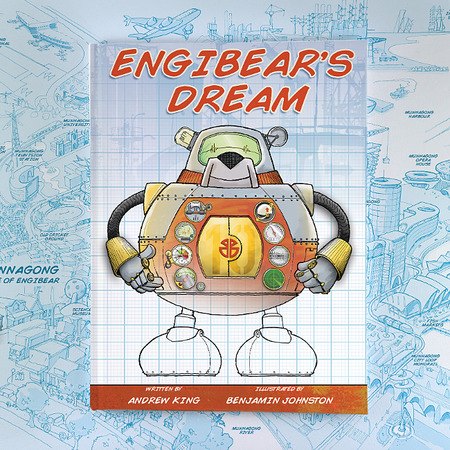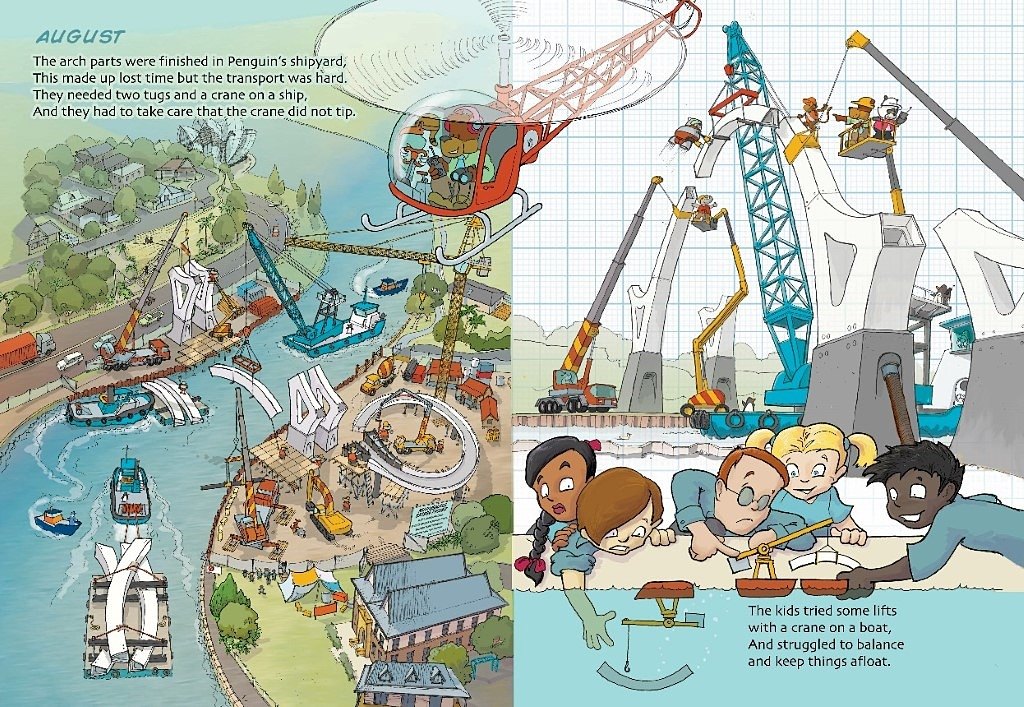The importance of new stories to encourage our next generation of engineers
December 17th, 2018
GUEST POST - ANDREW KING
Participation rates in science, technology, engineering and maths (STEM) subjects at schools are falling and we need to improve student interest in them. Creative writing can be used to build bridges to the STEM subjects. Stories, illustrations and the places, things, events and characters within them are ideal tools for encouraging children to explore and create within the STEM subject areas. Historically the use of story books to portray the roles played by STEM professionals has been limited. However, recently this has started to change - a trend that we hope continues to grow.
Story Books about Engineering
In 2008 David Janosz noticed that in the USA “…there were a large number of books available about people working in a limited few professions like fire fighters, artists, athletes and celebrities, rather than books about more prevalent occupations”. He could not find any books related to engineering. Locally, a study by Holbrook et.al. (2009) confirmed that there were very few children’s books about engineering. In a sample of 4,800 junior fiction books (8-12 years) in Australia only one contained the word ‘engineer’.
Fortunately authors such as Janosz (Engineers Decide, 2014) started producing children’s books about Engineering and while there are still relatively few titles it is encouraging that some of these books are doing well; for example, Rosie Revere Engineer (2013) was a New York Times Best Seller.
Globally there are tens of millions of Engineers. However, we need more engineers, with new skill sets to help address global issues like the provision of energy and water as well as climate change. Furthermore, in Australia, while there are about 300 000 engineers we do not produce enough ‘home-grown’ engineers or female engineers. This must change; we need a larger and more diverse engineering workforce to meet our national ambition of becoming a more productive and innovative nation. One place to start is early engineering engagement.
"Young children love the things engineers do and create and, in many ways, engineers are just big children - we all like to make things"
Young children love the things engineers do and create and, in many ways, engineers are just big children - we all like to make things. This natural connection is a way to improve children’s engineering awareness and facilitate their enjoyment of engineering. Accordingly, the Engibears books are designed to personalise engineering and make it accessible for young children through the combination of story, pictures and friendly characters. The engineering projects that Engibear, Engilina and the Bearbot work on in the fictitious city of Munnagong have parallels to both the work that engineers do in our own communities and to the activities that children undertake when they are playing and creating.
The Engineering Design Process
A common feature of the Engibears books is the Engineering Design Process - essentially the way engineers work. Aspects of the process are illustrated in each of the books and this seems to have been effective:
- Engibear’s Dream: “I don’t think I have ever read a picture book that demonstrates the engineering and working technologically process so well.” (Learning Hub, Vol 2, 2015).
- Engibear’s Bridge: “Engibear’s Bridge is an excellent representation of the whole civil engineering process for young readers”. (The Literature Base, 2016).
- Engilina’s Trains: “The growing popularity of STEM subjects in schools indicates the importance attached to areas of study such as Engineering. The bright and busy text contributes to this reputation by engaging young readers, enhancing their knowledge and challenging their imagination to solve practical engineering problems.” (CBCA Reading Time, 2017).
"Dream, Draw, Develop, Decide"
As a companion to the books, we have developed a simple Early Engineering Design Process (EEDP) [Figure 1] that helps children to become young engineers, this cyclic process has four steps:
- Dream: thinking about making something.
- Draw: creating a plan and the “engineering drawings” required to make something.
- Develop: making something.
- Decide: testing what has been made to see if it is “Done” or if further work is needed.

Figure 1 The Early Engineering Design Process
The EEDP can be applied to common children’s activities, e.g. making a sand castle and less familiar ones such as balancing a load on a boat [Figure 2]. Engibear’s Bridge specifically illustrates real-world engineering alongside related children’s activities. The aim was to encourage children’s kinaesthetic learning and reinforce the engineering principles shown in the book.

Figure 2 Illustration from Engibear's Bridge
The EEDP can be tailored to suit the age and experience of the children involved. It can be used in a qualitative sense for straight forward activities; Does my sand castle look good and would I be happy living in it? And, it is robust enough to be used for complex activities that require quantification (a cornerstone of engineering); How long and wide should my boat be? Does it float? And, will it balance with 100g of mass on it?
Importantly the EEDP has a defined beginning and end point. Starting with Dream was deliberate, we want children to think about opportunities not just solutions to problems. Ending with Decide leading to Done was a key element as it gives children ownership and closure which reflects real-world engineering. We routinely run engineering workshops for children and the importance of closure to the participants sense of achievement can’t be overstated; “Yes, I did build a bridge and it worked - the truck drove across it!”
"There are few existing stories and the profession covers such a diverse range of topics that the opportunities to engage children are virtually limitless."
To Conclude ...
There is clearly a need for more children’s books about engineering. There are few existing stories and the profession covers such a diverse range of topics that the opportunities to engage children are virtually limitless. I think the same can be said of the other STEM professions. Perhaps creating STEM related children’s books is something more authors and illustrators should consider. If collectively, we do it well, hopefully we can inspire children to Dream, Draw, Develop and Decide - to become tomorrow’s innovators.
Written by Andrew King the author of the Engibear series, including 'Engibear', 'Engibear's Bridge' and 'Engiliana's Trains'. You can find out more about Andrew at www.engibears.com
References
Beaty Andrea (2013) Rosie Revere Engineer. Illus. by Roberts David. Abrams Books for Young Readers. New York, USA.
Holbrook Allyson, Panozza Lisa and Prieto Elena (2009). Engineering in Children’s Fiction – Not a good story? International Journal of Science Mathematics and Education (2009) 7:723-740.
Janosz David (2014) Engineers Decide. Teach Ingenuity Concepts, LLC.
Tags: author, education, STEM
Comments (0)
No comments have been submitted yet.
Why not be the first to send us your thoughts
Leave A Comment
Thank you for your comments,
they will appear shortly once approved.
TOPICS
EducationIllustrator SpotlightThe Indie Author seriesAuthor PostSTEMGuest postsDivorceAuthor Q&AInterviews
RECENT POSTSHAVE YOU SEEN...1
A cheeky glimpse behind the scene of new release My Dog Bruiser Swallowed a ScooterJune 18th, 20242
Dr Nickers talks to Little Steps Australia about capturing the day-to-day magic in everyday lifeMarch 11th, 20243
Paul de Guingand sits down with Little StepsMarch 4th, 20244
Step into the Secret Doorway with Author Catherine SheridanMarch 4th, 20245
"Take your time to walk, observe, ponder and wonder" - meet Lee FullARTon and her latest creationJune 13th, 20231
Creating your indie-author brand. The online edition!April 30th, 20192
The Indie Author’s Self-Publishing ChecklistMarch 1st, 20183
Introducing Lauren Thompson's There's A Bully in my BrainFebruary 24th, 20234
Guest Post - ‘Children and Anxiety’ by Karen Young, Author of ‘Hey Warrior’May 22nd, 20185
5 tips to become an author-illustrator power coupleAugust 6th, 2019